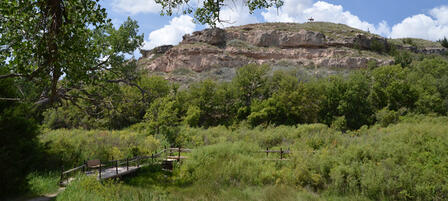Lake Scott State Park Renamed

TOPEKA - Kansas features many historic sites and landmarks, and the top of anyone’s must-see list is the state park soon-to-be formerly known as Lake Scott State Park. It’s still the same great park with amazing history, but beginning July 1, 2017, the park’s name will officially change to Historic Lake Scott State Park. Both chambers of the 2017 Kansas Legislature passed the bill proposing the name change unanimously. Governor Sam Brownback then signed the bill into law on March 29, 2017. Historic Lake Scott State Park is located along the Western Vistas Historic Byway about 11 miles north of Scott City, west of US-83 on K-95.
The move to add “Historic” to the park name was initiated by the Kansas Department of Wildlife, Parks and Tourism (KDWPT) to recognize the historical significance of the land and the lake to Native Americans, the State of Kansas, Scott County and surrounding areas. The remains of the northeastern-most known Native American pueblo – El Cuartelejo – are in the park, and the park is entirely enclosed within the El Cuartelejo Archeological District National Historic Landmark. More than 26 archeological sites have been documented within and adjacent to the park’s boundaries.
El Cuartelejo was the name given to a Plains Apache village where Taos Indians fled in 1664 to escape Spanish rule in the Southwest, and they built and occupied the pueblo for about 20 years. The pueblo was reoccupied ca. 1700 when Picuris Indians, also fleeing Spanish rule, settled there for about six years. The last known reference to El Cuartelejo was in 1727, after which it was abandoned and left to the ravages of weather and erosion.
About one mile south of the park is Battle Canyon, the site of the September 1878 Battle of Punished Woman’s Fork – the last battle between Native Americans (Northern Cheyenne) and the U.S Cavalry in Kansas.
The Herbert and Eliza Steele House, the home of early settlers in the area, was completed circa 1894 and has been preserved in the park much as it was more than 120 years ago. It is listed on the National Register of Historic Places and the Register of Kansas Historic Places. The Steele’s understanding of the important history of their land paved the way to the discovery of El Cuartelejo. In 1922, they deeded two acres of the historic El Cuartelejo site to the Kansas Society of the Daughters of the American Revolution (DAR) so it could be preserved and shared with the public. The DAR built a monument at the site which still stands. The DAR has since deeded the site to KDWPT. The Steeles’ willingness to share the beauty of their land led to the creation of the state park and the lake, which opened in 1930.
A flood in August, 1933 destroyed about 100 feet of Lake Scott’s dam. The Civilian Conservation Corps (CCC) was quickly enlisted to repair the dam and make other park improvements, which they completed in May, 1934. Remnants of the CCC camp are still visible in the park. Another notable feature of the park is the beach house built in 1930 at the swim beach. It is an example of revival Spanish architecture and currently serves as concessions for the public.
Listed by National Geographic as one of the country's 50 must-see state parks, Historic Lake Scott State Park is a stunning oasis of natural springs, deep wooded canyons, craggy bluffs and early American history. The 1,020-acre park is in Ladder Creek Canyon and surrounds the 100-acre Scott State Fishing Lake. Several active springs and Ladder Creek feed the lake. A 160-acre wildlife area also lies west of and adjacent to the park.
–30–









